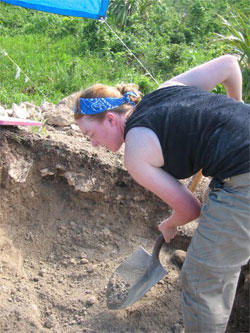Students will have the chance to experience the lush rainforests and shady trees of Belize while excavating thousands of ancient Mayan artifacts in a two-week research program this summer, said the program’s director. For the past 14 summers, the nonprofit Maya Research Program has given students, regardless of their majors, the chance to participate in a two-week field research session in the Blue Creek Village in Belize, a country in Central America.
“Blue Creek is one of the best research sites in the Maya area,” said Tom Guderjan , Blue Creek and Maya Research Program director.
Guderjan said participants have excavated everything from pyramids to the third-largest jade cash, equivalent to gold in the Mayan culture, in the world.
The Maya Research Program teaches and trains student volunteers how to exhume ancient artifacts and document what they find, he said.
Guderjan said the program has changed several people’s lives and some will continue to study anthropology after they graduate.
Meghan Dennis , a senior anthropology major who worked at Blue Creek, said: “It’s not like anything you can imagine.”
Dennis said she learned how to dig, map sites, prepare reports and do extensive research in Belize, which is necessary for her current job in cultural resource management.
John Comer , a senior anthropology major who has traveled to Blue Creek for the past two summers, said the Blue Creek program is especially helpful for those who plan to enter anthropology professions after they graduate.
Guderjan said the trip can be counted as course credit for anthropology majors.
“I learned more about the actual process of archaeology in one month (from this program) than in all the archaeology classes I have taken to date,” Comer said.
Besides adding the archaeology experience to your rÂsumÂ, you can enjoy the attractive scenery in Belize Dennis said.
Comer said it’s amazing to spend a month digging in dirt that seems unimportant but then discovering buried artifacts like tools and pottery that haven’t been seen by human eyes for over 1,100 years.
Dennis said that when participants discovered the jade cache it was like finding gold because it was the highest form of commodity to the ancient Mayans.
Adventure and riches may sound like it’s for everyone, but Comer and other participants said they had to be willing to adapt to the wilderness.
“It is what I would call ‘roughing it’,” said Brittany Croxdale, a senior radio-TV-film major who went to Blue Creek last summer.
“It made my life in the states seem like a piece of cake,” Croxdale said.
Croxdale said she learned about the Mayan way of life in this program, but had to adjust to long, hot days and do without some ‘essentials,’ like phone, Internet and hot water.

